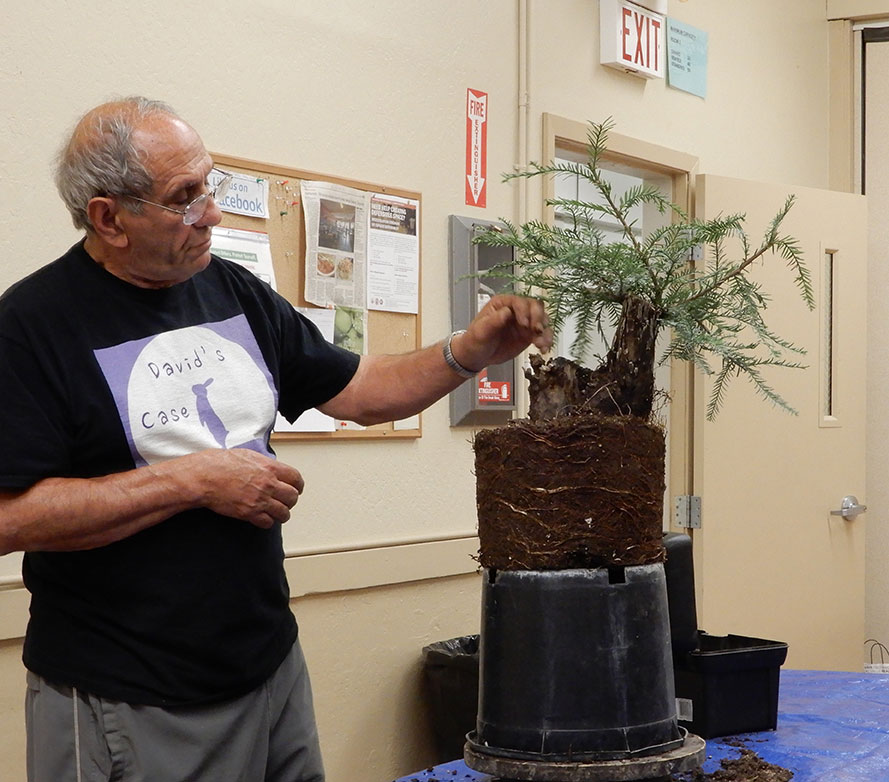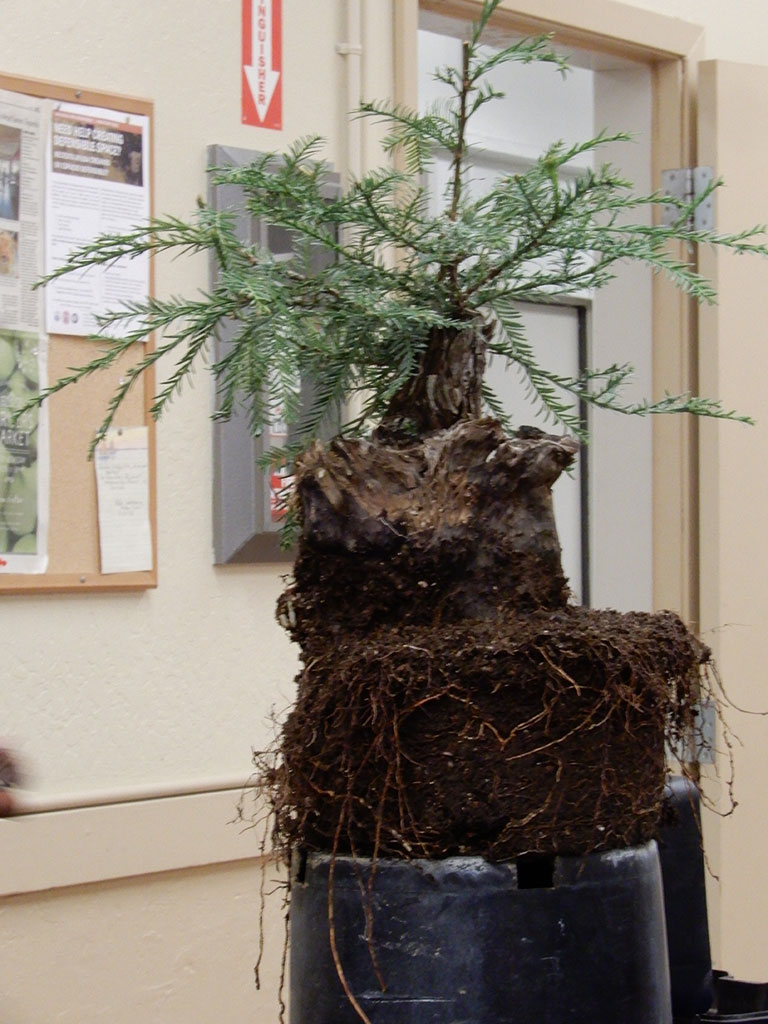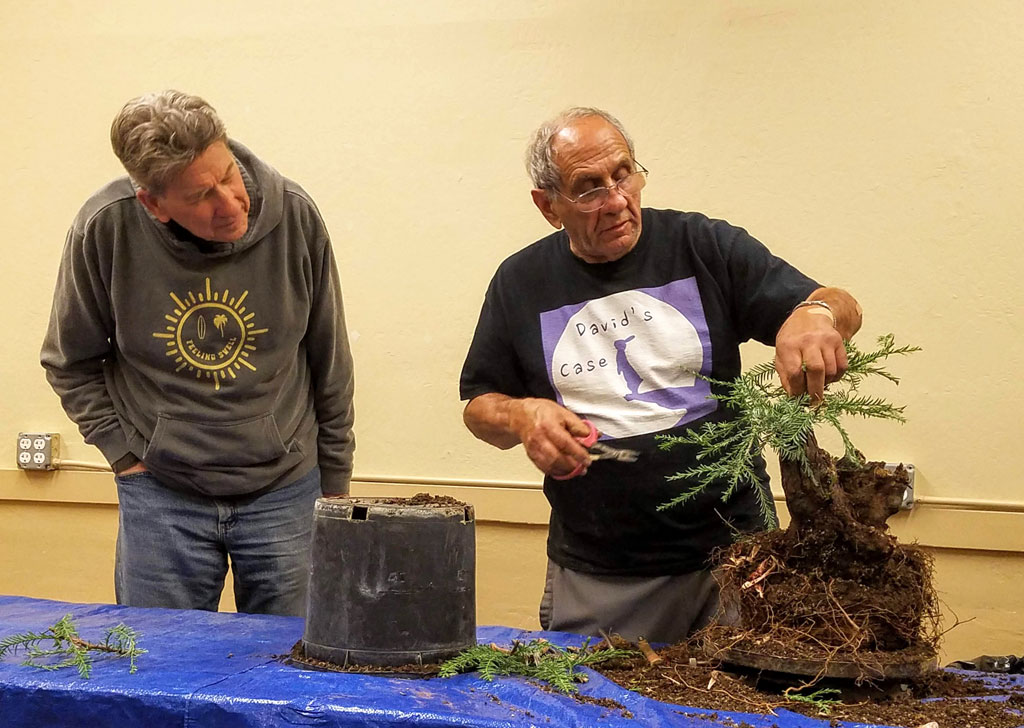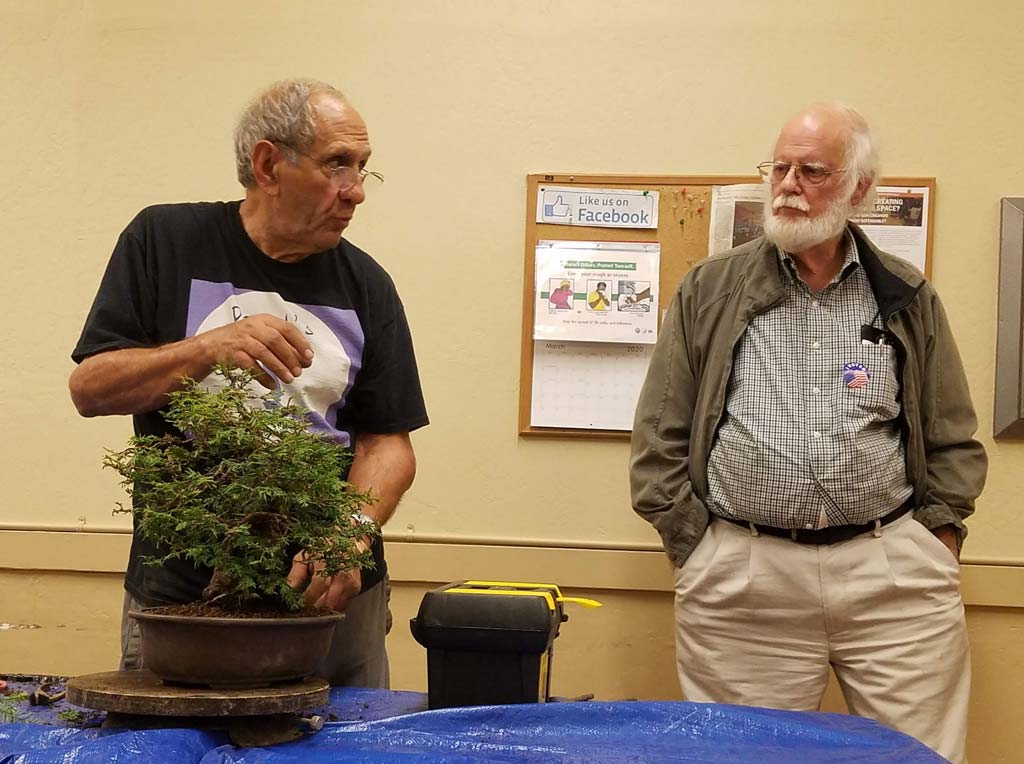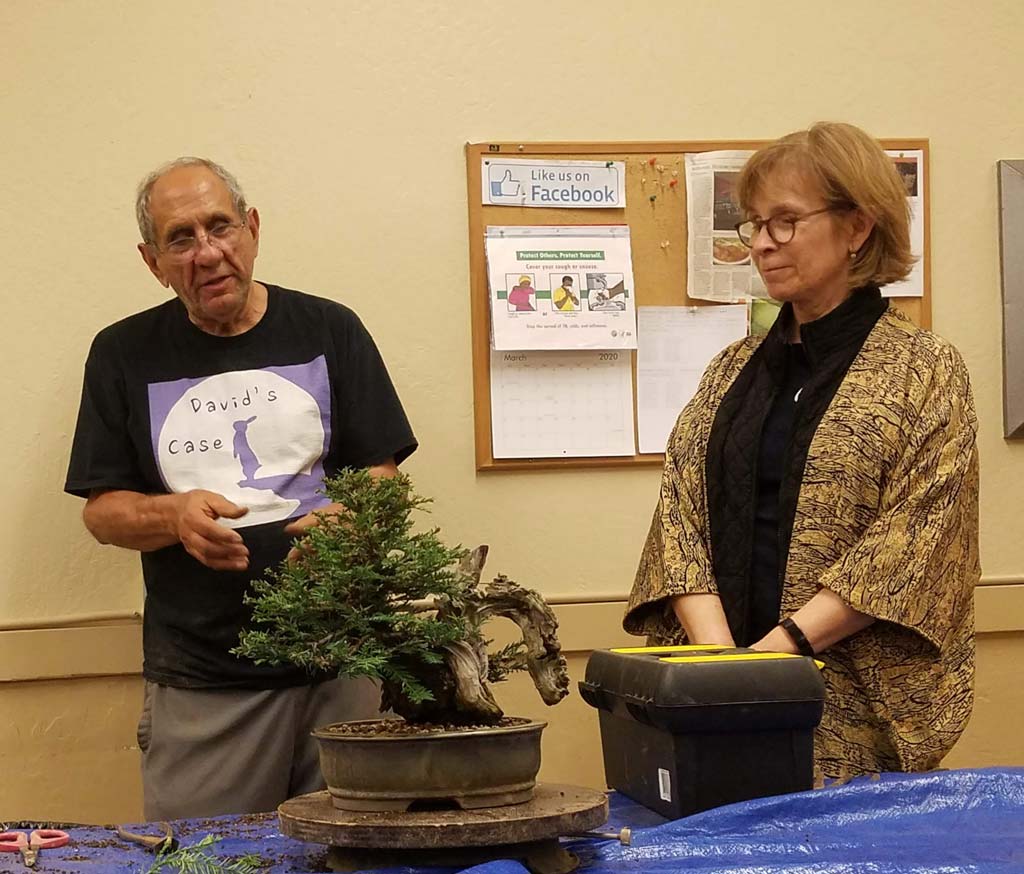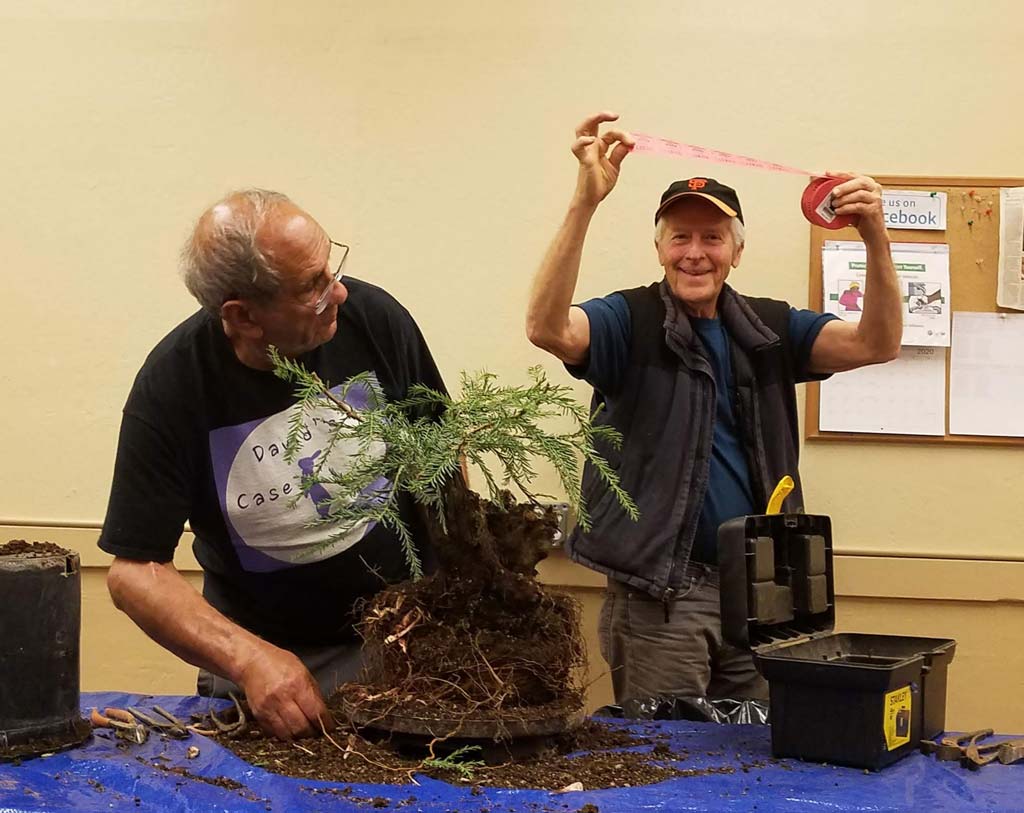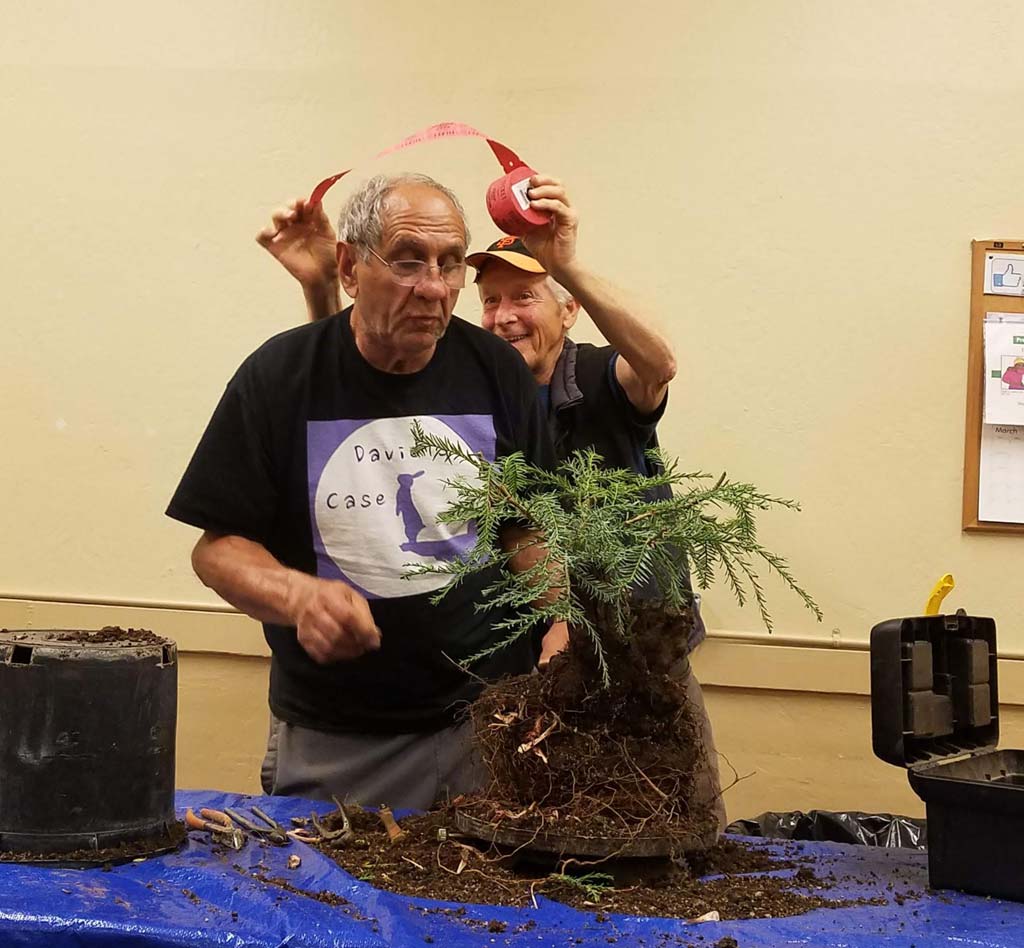In March of 2020, with pandemic-related uncertainty at its highest and information at its lowest, the Marin Bonsai Club had what would be its last meeting before the official stay-at-home order. Our last guest of honor: President of the Redwood Empire Bonsai Society and owner of Mendocino Coast Bonsai, Bob Shimon. He came to talk to us about redwoods and demonstrate some work on a relatively young sample of the species, which was raffled off at the end of the night.
After telling us a little bit about himself and his business in Port Arena, Bob introduced the trees he brought for illustration purposes and the subject of the evening, a nice healthy pre-bonsai redwood. It had been a much larger, but still relatively juvenile tree, and it was collected via backhoe from a private yard that was being completely renovated a little over a year prior to the present evening. The large main trunk was removed at the time of collection to favor the smaller saplings at its base. Because he has more trees as part of his business than anyone can remember in detail, Bob was reconstructing the recent history of the demo tree as he worked. But he quickly knew this tree had been collected relatively recently based on its soil and the type of pot it he had it in, and then began to recognize it further as his work became more involved.
Bob always uses a sandy mix and an oversized container for newly collected trees, to encourage lots of fine feeder roots. The presence of both is what tipped him off that this tree had been in his collection for less than two years. He removed the tree from its pot, knocked away some of the soil, and confirmed that there were plenty of new roots on the tree now, forming a mass much wider than the base of the trunk. Bob pointed out that most of those roots grew since the tree was collected. Much like olive trees, redwoods can lose a very high proportion of their roots and still recover, greatly simplifying the collection process and vastly increasing the chances for success.
By the way, for those unfamiliar with the term, “collect” in this context is used to indicate the bonsai-specific act of gathering a specimen from a wild (with proper permits) or privately landscaped area. In other words, it’s the process of turning something that was once growing mostly or entirely on its own, and in the ground, into a potted tree ready to be transformed slowly into bonsai, a stage known as pre-bonsai. Aside from the removal of oversized parts, like the large original trunk, collected trees are left virtually untouched and extremely pampered long enough for them to reestablish a healthy root system.
While on the topic of the demo tree’s root ball, Bob said that the eventual winner of the demo tree should repot it at their earliest convenience, because it’s ready to move on from the sandy root-establishment medium to true bonsai soil. He said that redwood trees can be given pure Akadama (the baked clay soil pellets that are the cornerstone of good moisture-retaining bonsai soil), but can be happy in a variety of soils, as long as they contain at least half Akadama. They’re moisture loving trees after all. He went on to say that the demo tree winner should completely clean the roots of all current soil, and cut the major roots about halfway back. He also pointed out that the demo tree might benefit from some tilt when it’s repotted. And a final note on the topic for all of us: avoid repotting redwoods when it’s hot out!
Once he was finished examining the demo tree’s roots, Bob focused on the base of the trunk next, cutting away the long runner/sucker branches that had sprouted there in the spring. He cut those away for two reasons: because they’ll sap energy from the rest of the tree otherwise, and because most of the tree’s inherent interest resided in the base of the trunk and those stringy, unwanted branches were blocking it from view. He said that this area of the tree is interesting enough that the winner of the tree shouldn’t bother carving on it, with the exception of the stump where the bulk of the original tree was sawed off. That needed some jiining to make it look natural instead of straight cut. He asked for some audience participation to help strip outer layers of the stump, but said that he would just get it started and the eventual winner would be able to add their own touch to it. He also pointed out that in most cases lime sulphur is not needed for redwoods, because they resist rot. Use it if you please, but the whitening it causes is also not natural-looking on redwoods. If you insist on using lime sulphur, consider coloring it to tone down the bright white.
With the jiining on the stump far enough along, Bob garnered audience opinion to help choose the front and then the apex of the tree. As soon as the preferred apex was decided upon, Bob promptly lopped off the strongest alternate. He then proceeded to wire the branches to give them a bit of an umbrella shape, while giving some more general information about redwoods.
Bob says one of the most frequent questions he gets is how to fix legginess in redwoods, that annoying tendency some trees have to look like skeletons of proper bonsai. The first part of his answer was that redwood bonsai are notoriously high maintenance. You need to trim them successively over time for optimum results. Secondly, because they want to grow tall and skinny, and favor their growth tips, they will gladly let lower and interior branches die to distribute more energy to the ends of their upper branches. Therefore, the bonsai artist’s job is to develop fuller branches that the tree is willing to keep alive, and that satisfy bonsai aesthetics, without trimming in such a way as to force the tree to give up on one or more branches entirely.
The first thing to bear in mind when trimming leggy branches on a redwood is that you will have to work them back gradually. Redwoods will bud from almost anywhere, and every leaf-like collection of needles will eventually become a branch and can itself be branched, but one wrong cut can be catastrophic. In particular, if you don’t leave some pre-existing lateral growth on a branch that you’re shortening, the whole branch will almost certainly die back. Your only consolation in that predicament will be the exceptionally high likelihood that new shoots will pop out of the origin point of the now-dead branch.
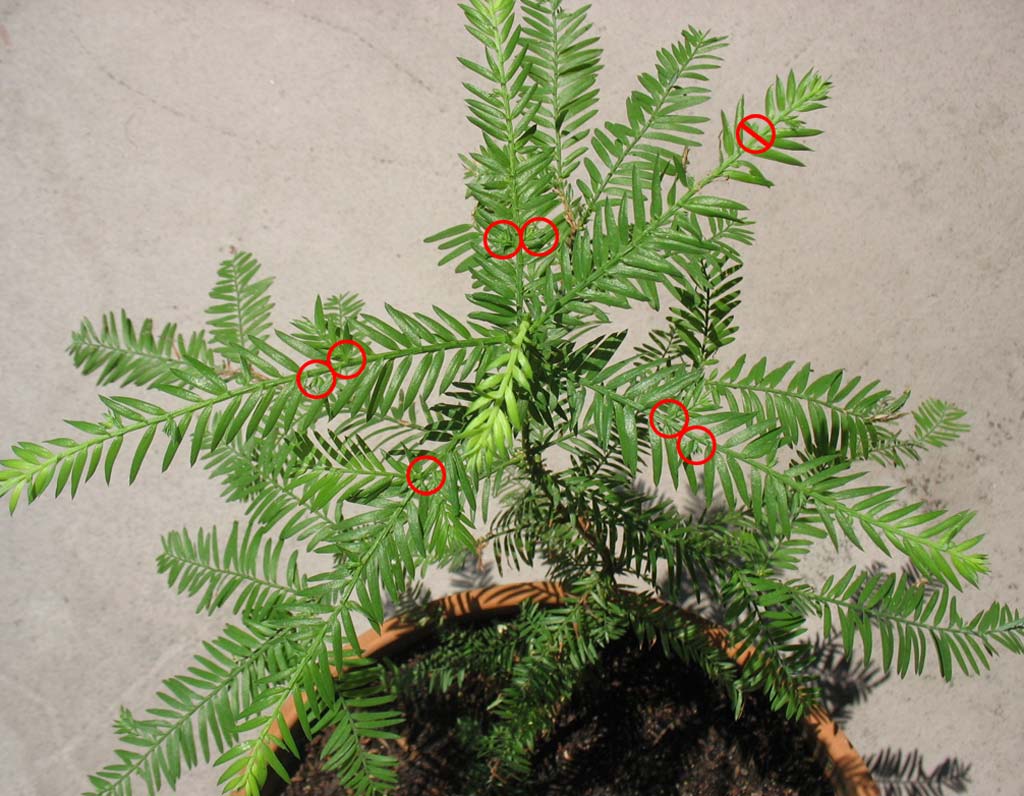
The solution is to check the branch for adventitious buds or other lateral growth and make sure your cut is farther away from the trunk to preserve that growth, along with the tree’s interest in keeping the branch alive. The photo here, of a very young sample tree that was not part of Bob Shimon’s demo, has red circles to indicate nice close-in lateral growth points that would allow the branches to survive if cuts were made just beyond them. Trimming the upper branches in this way on this particular tree would redirect energy to help bulk up the lower branches and prevent the tree from letting them die away, without disturbing the apex.
Note the branch in the photo with no buds until almost at the tip, with the slash through the circle. Only the very tip of this branch can be removed at this time. In cases like this, where the only lateral growth is not as far in toward the trunk or main branch as you would ultimately like, that’s where the multiple trims over time become important. After you make the first cut, more buds are likely to appear along the length of the branch, allowing you to cut closer-in next time. Bob gave one final tip for trimming redwoods: back-budding is most likely to occur if branch tips are pinched when they’re young and tender.
Bob gave some general redwood care advice as he finished wiring the demo tree. He recommends a balanced fertilizer, with no number over 10, for the growing season. He switches to a 0-10-10 for the winter, since redwoods don’t grow much during the winter. His favorite form of fertilizer is granular. It’s also important to know that redwoods are acid-loving trees. Finally, redwoods can take heat, but they’ll burn under direct sun, so partially sunny or shaded areas are best for them.
After finishing the demo tree, Bob started giving tips for member trees that were brought in. He took one look at the pine tree Diane Matzen had just acquired at the previous meeting and got a few gasps from the audience as he lopped a huge extraneous piece off of it. Then he looked at a tree of Peter Miller’s that had lots of branches dying back, and said that it might have been cut back too early. After looking at a couple more member trees, Bob drew the ticket for the raffle and Chris Ross won the demo tree. Chris promised to bring the tree back so we can see how it develops and learn from what further things he does to it.
– David Eichhorn
Photos courtesy of George Haas, Sharon Bone and David Eichhorn


